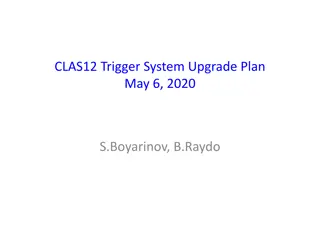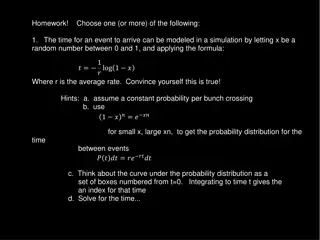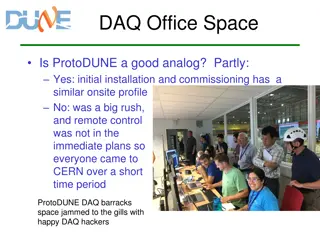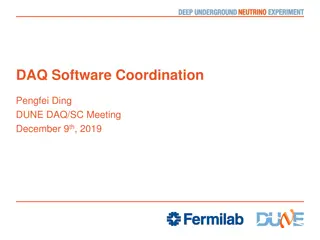Understanding DAQ Trigger Issues in SoLID Experiment
Explore DAQ trigger challenges faced in the SoLID experiment through examples, including trigger goals, data readout specifics, and experiment setups. Learn about managing high luminosity, reducing data rates, improving signal quality, and handling bottleneck issues for effective data acquisition. Discover insights into trigger strategies for reducing background noise and enhancing event selection.
Download Presentation

Please find below an Image/Link to download the presentation.
The content on the website is provided AS IS for your information and personal use only. It may not be sold, licensed, or shared on other websites without obtaining consent from the author. Download presentation by click this link. If you encounter any issues during the download, it is possible that the publisher has removed the file from their server.
E N D
Presentation Transcript
Example of DAQ Trigger issues for the SoLID experiment Alexandre Camsonne Workshop on Future Trends in Nuclear Physics Computing March 17th2016
JLab DAQ specifics Almost continuous machine : 499 MHz repetition rate usually prevents to trigger on beam crossing like at collider usually trigger on detector High luminosity up to 1039 cm-2s-1 Typical scale of experiments if of order of 100 M$ ( different from HEP and CERN LHC ) Several different setup run for a few years Workshop on future trends in Nuclear Physics Computing DAQ Trigger 8/18/2024 2
Trigger goals Reduce rate so it can be handled by the electronics Front end dead time Data transfer Reduce data size Only record event of interest Improve signal to background Workshop on future trends in Nuclear Physics Computing DAQ Trigger 8/18/2024 3
Data readout VME Calo 100 MB/s Ethernet 100 MB/s CPU Cerenkov DLO6 Tape 250 MB/s SAS 250 MB/s FADC Scintillator Event Builder L3 Drive Silo APV transfer 80 MB/s CPU MPD CPU GEM APV DAQ bottle necks VME 100 MB/s Workshop on future trends in Nuclear Physics Computing DAQ Trigger 8/18/2024 4
Example SoLID PVDIS experiment Inclusive electron scattering Calorimeter and Gas Cerenkov 200 to 500 KHz of electrons Maximum 1.8 MHz total rate 30 individual sectors to reduce rate per sector to 60 KHz maximum Workshop on future trends in Nuclear Physics Computing DAQ Trigger 8/18/2024 5
FADC readout FADC readout full waveform 10 samples Only want to readout FADC channel in the cluster to reduce number of channels readout because of background in case zero suppression does not work CTP generates a 64 bit pattern Send pattern to TI or FADC directly to trigger FADC Only channels from pattern are put in buffer Workshop on future trends in Nuclear Physics Computing DAQ Trigger 8/18/2024 6
ECAL trigger Workshop on future trends in Nuclear Physics Computing DAQ Trigger 8/18/2024 7
Calorimeter Geometry Detector segmented in 30 sectors One crate per sector CTP CTP Workshop on future trends in Nuclear Physics Computing DAQ Trigger 8/18/2024 8
CTP connections To neighbor CTP To neighbor CTP Workshop on future trends in Nuclear Physics Computing DAQ Trigger 8/18/2024 9
Neighboring sectors New CTP : has two additional optical links Can send Cerenkov and calorimeter edges to other sectors. CTP CTP CTP 8 Gbp/s optical link 8 Gbp/s optical link 8 Gbp/s optical link 36 calorimeters 9 Cherenkov 150ns + 5 ns per m+ 300 ns ( data ) = 500 ns overhead Trigger decision = 500 ns (Transfer ) + 1us ( clustering ) < 4 us (APV) Workshop on future trends in Nuclear Physics Computing DAQ Trigger = 8/18/2024 10
PVDIS electron trigger Coincidence ECAL and Gas Cerenkov Singles ECAL 286 KHz Singles rates Cerenkov 2 MHz Accidental 30 ns 16.6 KHz DIS electron 10.4 KHz Total rate 27 KHz Workshop on future trends in Nuclear Physics Computing DAQ Trigger 8/18/2024 11
Event size FADC PVDIS with waveform Detector Total number of channels Number of channels firing Number of samples Max size detector bytes Minimal size detector bytes Typical size Shower 58 7 10 2784 336 772 Preshowe r 58 7 10 2784 336 772 Gas 9 3 10 432 144 432 Cerenkov Max total size 46KB 0.816KB 1.544KB Max rate Assuming 100 MB/s per crate One crate 2.1 KHz 121 KHz 60 KHz FADC data rate for 30 KHz = 60 MB/s Workshop on future trends in Nuclear Physics Computing DAQ Trigger 8/18/2024 12
GEM readout APV25 Front GEM ASICs Up to 164 000 channels APV 25 : 128 channels Readout VME based readout : 16 APV25 = 2048 channels ( ~ 10 $ / channels ) SRS readout : ethernet /PC based = 2048 channels ( ~ 3 $ / channels ) 1 crate per sectors for FADC and GEM Workshop on future trends in Nuclear Physics Computing DAQ Trigger 8/18/2024 13
APV25 readout Switch Capacitor Array ASICS with buffer length 192 samples at 40 MHz : 4.8 us Look back 160 samples : 4 us t_APV = 141 x number_of_sample / 40 MHz APV readout time : t_APV(1 sample) = 3.7 us. Max rate APV front end : 270 KHz in 1 sample mode 90 KHz in 3 samples mode Will be triggered at max 60 KHz in 3 samples 100KHz Max in 1 sample Optional on chip deconvolution Front-end FPGA deconvolution being implemented Deadtimeless pipelined electronics / parallel read and write Workshop on future trends in Nuclear Physics Computing DAQ Trigger 8/18/2024 14
GEM event occupancy and size 3 samples ( bytes) 4776 3528 2568 2448 2448 15768 Sector 0 1 2 3 4 Rate 199 147 107 102 102 657 XY 398 294 214 204 204 1314 Bytes 1592 1176 856 816 816 5256 Total hits / sector Data rate / sector 30000 157680000 473040000 Data rate ( sector Mb/s) Total detector ( x30) Occupancy detector 157,68 4730.4 473.1 14191.2 19710 0.14 Data rate to front end reading 3 samples Use 4 Gigabit link = 512 MB/s not for safety Workshop on future trends in Nuclear Physics Computing DAQ Trigger 8/18/2024 15
GEM event occupancy and size after deconvolution 3 samples ( bytes) 552 288 240 216 216 1296 Sector 0 1 2 3 4 Rate 23 12 10 9 9 63 XY 46 24 20 18 18 126 Bytes 184 96 80 72 72 504 Total hits / sector Data rate / sector 30000 1512000 77760000 Data rate ( sector Mb/s) Total detector (x30) Occupancy detector 15.12 453.6 45.36 1360.8 1620 0.013 Rates with deconvolution 3 samples readout Implementation in readout electronics No issue for transfer up to 60 KHz ( 90 MB / s ) Data after processing going to tape Workshop on future trends in Nuclear Physics Computing DAQ Trigger 8/18/2024 16
Future chip VMM family Zero suppression ADC and TDC on chip Logic function with input from other chips Reduce data on the ASIC stage and then on front end stage using FPGA before sending to readout controller Workshop on future trends in Nuclear Physics Computing DAQ Trigger 8/18/2024 17
L3 Farm blocked event fragments partially recombined event fragments full events All nodes connected with 1GB/s links ROC Switches connected with 10GB/s fiber optics EB1 Event Builder stage 1 ROC Read Out Controllers EB2 Event Builder stage 2 node ROC node node ROC Raid Disk EB1 Event Builder stage 1 L3 Farm ROC ER Event Recorder node ROC node EB2 Event Builder stage 2 node node ROC EB1 Event Builder stage 1 ROC ROC Level-3 Trigger and monitoring Front-End Crates Staged Event Building Event Recording ~60 crates ~50MB/s out per crate N x M array of nodes (exact number to be determined by available hardware at time of purchase) 300MB/s in 300MB/s out Workshop on future trends in Nuclear Physics Computing DAQ Trigger 8/18/2024 18
PVDIS data rates Simulation and trigger were checked and optimized Trigger rate estimated to be 27 KHz GEM data rate assuming 30 KHz after deconvolution around 46 MB/s FADC data 60 MB/s Total about 108 MB/s per sector to L3 x 30 for a total 3.24 GB/s Use L3 to reduce to 250 MB/s ( similar to Hall D ) Workshop on future trends in Nuclear Physics Computing DAQ Trigger 8/18/2024 19
L3 data reduction Can use slow detectors that cannot be used at L1 Pile up detection Only record sample for event with pile up Calorimeter clustering GEM readout and tracking Timing cut Clustering Crude tracking Tracking Improved timing to reduce accidentals Workshop on future trends in Nuclear Physics Computing DAQ Trigger 8/18/2024 20
Tape size Days Data rate SecondsTotal data Doubl e DLO5 in $ DLO6 in $ TB 1036800 0 E12-11-108 Pol proton 120 250 2592 5184 259200 155520 E12-12-006 J/Psi 60 250 5184000 1296 2592 129600 77760 E12-10-006 Transv. Pol. 3He 90 250 7776000 1944 3888 194400 116640 E12-11-007 Long. Pol. 3 He 35 250 3024000 756 1512 75600 45360 1460160 0 E12-10-007 PVDIS 169 250 3650.4 7300.8 365040 219024 4095360 0 20476. 8 102384 0 Total 474 10238.4 614304 Workshop on future trends in Nuclear Physics Computing DAQ Trigger 8/18/2024 21
Conclusion SoLID requires high rates low dead time, flexible trigger capability Use of JLab pipeline and CODA3 electronics allows almost deadtimeless electronics and makes this experiment possible Serial readout and on board processing are additional available tools L3 farm capability similar to HEP in smaller scale gives more flexibility on the trigger Limiting factor : readout speed of the data from the modules and tape price Workshop on future trends in Nuclear Physics Computing DAQ Trigger 8/18/2024 22






















